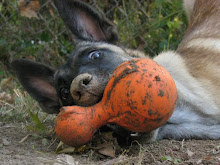July 30, 2008 - A Big Day
- Finger Point - The handler points to a target (in this case a paper plate with a treat on it), gives the dog the command "run", and sends the dog out to the target. The target is about 8 ft away.
- Sit Stay - The dog must sit while the handler walks out 6 feet. The dog must stay in a sit for 30 seconds.
- Down Stay - Just like the sit stay, only the dog is in a down.
- Hand Kiss - The dog follows the handler's open hand as he leads the dog around his body and into a sitting position at the handler's side.
- Loose Leash - The dog walks next to a handler with the leash loose at all times. If the dog starts to stray, the handler can call the dog's name or say "come" to get the dog's attention.
In the coming weeks we will build on these and sit stays will be longer, plus new requirements.
Other exciting events in the world of Mika...
Mika got her first taste of the electric collar. It was my first experience too.
Dogs get collar smart and learn to act a certain way only when a specific collar is on. To avoid this, Mika's been wearing the e-collar for a few days now, getting used to having it on. Then, just before I planned to use the collar for a correction, I put a fur saver choke chain on her neck. Then, I wait for her to display the undesired behavior and gave her a correction.
By putting the choke chain on, she will associate the correction from the choke chain and not the actual e-collar. Down the road, I can phase the e-collar out and she can wear a loose choke chain always believing that she could receive a correction at any given moment from the dummy choke chain. We use a choke chain because in the show ring, only a choke chain can be worn. For the average pet owner, the same concept could be applied to a regular flat collar or even a dog tag. For the first week or so of using the e-collar, you will have to put the dummy collar on just before beginning corrections to reinforce the belief that the dummy collar is the source of the correction. Never give a correction without the dummy collar.
For Mika, the behavior I want to extinguish is barking in her crate. She acts up in her crate to get my attention, even going into a fit scratching at the plastic pan in the bottom of her crate. This behavior is difficult to correct using treats, or even a pinch collar because it takes place primarily when I am not in the room. I hear her barking from the next room over but by the time I reach her she will not associate the correction with barking and she will only learn that if she barks, I come running in the room. With the e-collar I can give her a timely correction from another room. If the timing is really good, she will only need a couple of electric corrections to understand. I've never been a fan of the e-collar but I think if it's done right, it can reduce the learning time significantly and save the dog from countless corrections on the pinch collar. I only give her the minimum correction level needed to get her attention. There should be no pain involved, only a strange tingling sensation.
Mika also learned how to "out" when she's playing high drive prey games. When she catches a ball or a tug, it is becoming increasingly difficult to get the item back from her. She latches on and tries to figure out where she can go and hide with the toy so she can can lay down and chew it to her heart's content. In order to keep the game going and to keep her prey drive up, she needs to give up the toy so we can reinitiate play with her.
To achieve the "out", once Mika bites onto the toy, she gets the "out" command and a tiny pop on the pinch collar. As soon as she gives up the toy, she is rewarded by resuming play.


0 Comments:
Post a Comment
Subscribe to Post Comments [Atom]
<< Home